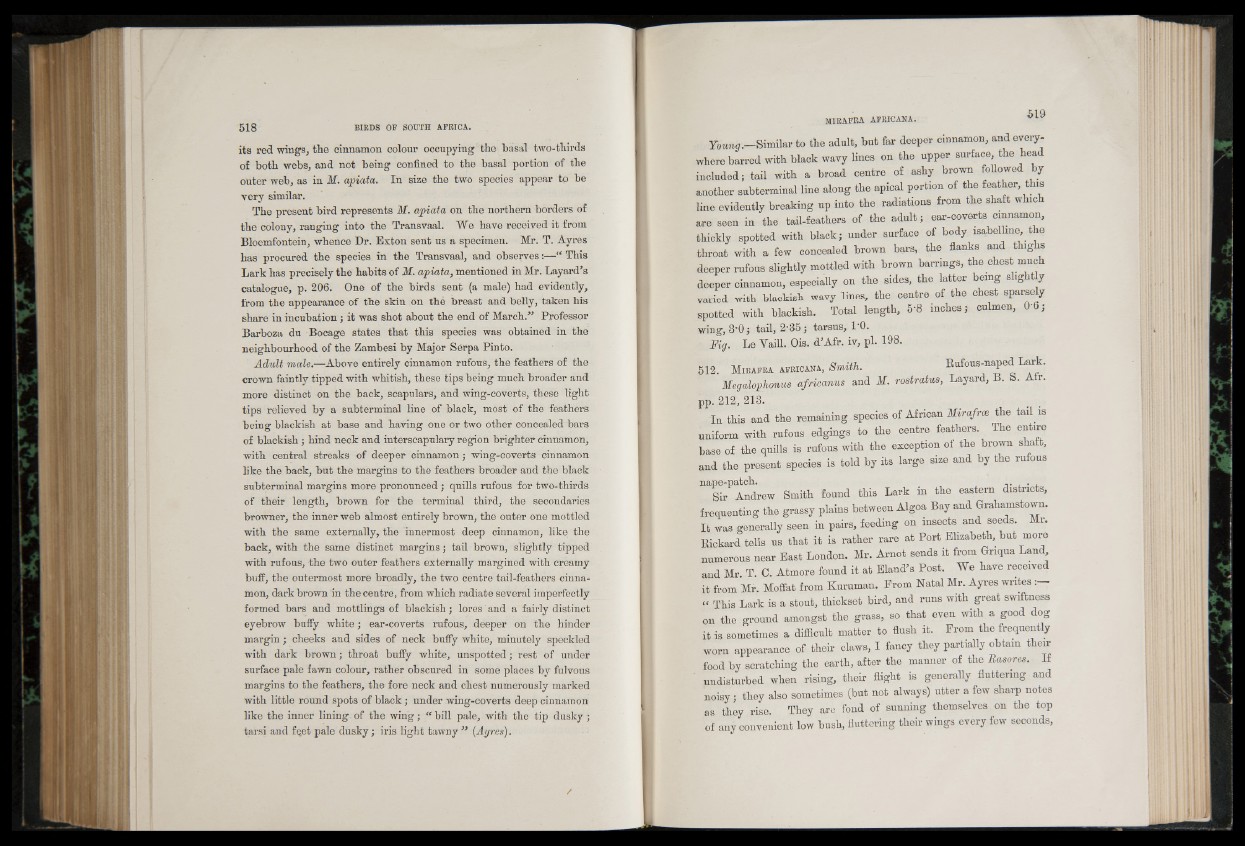
its red wings, the cinnamon colour occupying the basal two-thirds
of both webs, and not being confined to the basal portion of the
outer web, as in M. apiata. In size the two species appear tp be
very similar.
The present bird represents M. apiata on the northern borders of
the colony, ranging into the Transvaal. We have received it from
Bloemfontein, whence Dr. Exton sent ns a specimen. Mr. T. Ayres
has procured the species in the Transvaal, and observes:—“ This
Lark has precisely the habits of M. apiata, mentioned in Mr. Layard’s
catalogue, p. 206. One of the birds sent (a male) had evidently,
from the appearance of the skin on the breast and belly, taken his
share in incubation; it was shot about the end of March.” Professor
Barboza du Bocage states that this species was obtained in the
neighbourhood of the Zambesi by Major Serpa Pinto.
Adult male.—Above entirely cinnamon rufous, the feathers of the
crown faintly tipped with whitish, these tips being much broader and
more distinct on the back, scapulars, and wing-coverts, these light
tips relieved by a snbterminal line of black, most of the feathers
being blackish at base and having one or two other concealed bars
of blackish; hind neck and interscapulary region brighter cinnamon,
with central streaks of deeper cinnamon; wing-coverts cinnamon
like the back, but the margins to the feathers broader and the black
subterminal margins more pronounced; quills rufous for two-thirds
of their length, brown for the terminal third, the secondaries
browner, the inner web almost entirely brown, the outer one mottled
with the same externally, the innermost deep cinnamon, like the
back, with the same distinct margins; tail brown, slightly tipped
with rufous, the two outer feathers externally margined with creamy
buff, the outermost more broadly, the two centre tail-feathers cinnamon,
dark brown in the centre, from which radiate several imperfectly
formed bars and mottlings of blackish; lores and a fairly distinct
eyebrow buffy white; ear-coverts rufous, deeper on the hinder
margin; cheeks and sides of neck buffy white, minutely speckled
with dark brown; throat buffy white, unspotted; rest of under
surface pale fawn colour, rather obscured in some places by fulvous
margins to the feathers, the fore neck and chest numerously marked
with little round spots of black; under wing-coverts deep cinnamon
like the inner lining of the wing; “ bill pale, with the tip dusky;
tarsi and fqet pale dusky; iris light tawny ” {Ayres).
tiiq
m ir a f r a a f r ic a n a .
Young.—Similar to the adult, but far deeper cinnamon, and everywhere
barred with black wavy lines on the upper surface, the head
included; tail with a broad centre of ashy brown followed by
another subterminal line along the apical portion of the feather th.s
line evidently breaking up into the radiations from the shaft whic
are seen in the tail-feathers of the adult; ear-coverts cinnamon,
thickly spotted with black; under surface of body isabellme, the
throat with a few concealed brown bars, the flanks and thighs
deeper rufous slightly mottled with brown barrings, the chest muc
deeper cinnamon, especially on the sides, the latter being sl.ght y
varied with blackish wavy lines, the centre of the chest sparsely
spotted with blackish. Total length, 5'8 inches} culmen, 0 6 ;
wing, 3-0; tail, 2-35; tarsus, 1‘0.
Fig. Le Vaill. Ois. d’Afr. iv, pi. 198.
512. M ir a f r a a fr ic a n a , Smith. R u f o u s n a p e d Lar
Megalophonus africanus and M. rostratus, Layard, . . r.
p p . 212, 213.
In this and the remaining species of African Mirafroe the tail is
uniform with rufous edgings to the centre feathers. The entire
base of the quills is rufous with the exception of the brown shaft,
and the present species is told by its large size and by the rufous
nape-patch. .
Sir Andrew Smith found this Lark in the eastern districts,
frequenting the grassy plains between Algoa Bay and Grahamstown.
I t was generally seen in pairs, feeding on insects and seeds. Mr.
Rickard tells us that it is rather rare at Port Elizabeth, but more
numerous near East London. Mr. Arnot sends it from Gnqua Land
and Mr. T. C. Atmore found it at Eland’s Post. We have received
it from Mr. Moffat from Kuruman. From Natal Mr. Ayres writes:
“ This Lark is a stout, thickset bird, and runs with great swiftness
on the ground amongst the grass, so that even with a good dog
it is sometimes a difficult matter to flush it. From the frequently
worn appearance of their claws, I fancy they partially obtain their
food by scratching the earth, after the manner of the Basores. If
undisturbed when rising, their flight is generally fluttering and
noisy; they also sometimes (but not always) utter a few sharp notes
as they rise. They are fond of sunning themselves on the top
of any convenient low bush, fluttering their wings every few seconds,